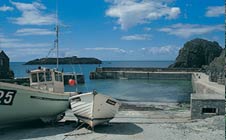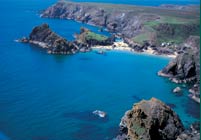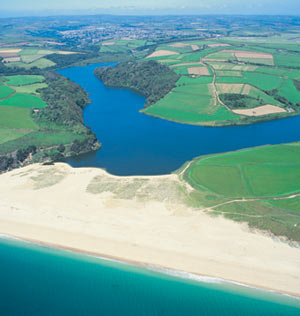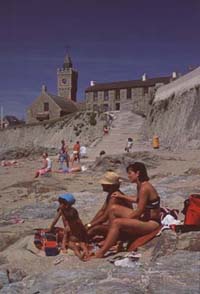   | |
Porthleven | |
| Local Accommodation and Business | |
|
A happy mix of working village and popular holiday centre, Porthleven offers a variety of accommodation and you'll find restaurants, pubs, galleries and gift shops trading alongside fishmongers and chandlers. A few yards from the harbour you can soak up the sun on the beach, or take the South West Coast Path cast to the wild Lizard Peninsula or west to the spectacular cliff-edge tin mines of Rinsey. Come in the summer and you'll catch Porthleven in its holiday clothes, with quayside concerts by the town band, gig racing and the festival of St Peter's Tide. As you stroll round the harbour, you'll be passing buildings which can tell a story or two of times past, when the quayside heaved with activity As you turn into Breageside, the three-storey building across to your right was built in 1889 as fish-curing cellars which turned out thousands of hogsheads of pilchards for export. The two cannon either side of the harbour were once fired in anger at Napoleon's navy during the battle of Brest and come from the frigate HMS Anson, wrecked on Lee Bar in 1807 with the loss of 120 sailors. Just round from the Ship Inn is the old lifeboat house, built in 1894. Porthleven had its own lifeboat service from 1863 to 1929, which ran 28 missions and saved 50 lives. The village retains strong links with the RNLI and each August holds a colourful Lifeboat Day. The Bickford-Smith Institute, with its imposing 70ft clock tower, was built in 1883 as a Literary Institute by William Bickford-Smith of Trevarno. The building featured in the national press in 1989, when pictures showed the tower engulfed by enormous waves . A walk to the nearby market town of Helston takes you along Loe Bar, a huge shingle bank separating the sea - it is not safe to bathe here - from the tranquil waters of Loe Pool. Quite a surprise after your seaside stroll, the beautiful lakeside and woodland paths take you through the National Trusts Penrose Estate, and along the Cober Valley to Helston.
| |
 Head
west on the A394 from Helston to Penzance and a left turn will bring you to Porthleven,
the most southerly port in mainland Britain and an excellent base for exploring
south west Cornwall.
Head
west on the A394 from Helston to Penzance and a left turn will bring you to Porthleven,
the most southerly port in mainland Britain and an excellent base for exploring
south west Cornwall.  Nearby,
the Myths and Legends attraction started life in 1893 as a china clay store; up
to 7000 tons of china clay from the Tregonning Hill quarries were kept here prior
to export. As you walk a little further on, you'll see a ruined turret-like building,
once a limekiln, built in 1814 to produce lime for the construction of
the harbour and the building boom which followed.
Nearby,
the Myths and Legends attraction started life in 1893 as a china clay store; up
to 7000 tons of china clay from the Tregonning Hill quarries were kept here prior
to export. As you walk a little further on, you'll see a ruined turret-like building,
once a limekiln, built in 1814 to produce lime for the construction of
the harbour and the building boom which followed.